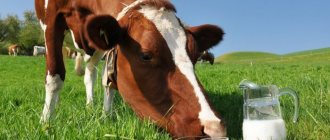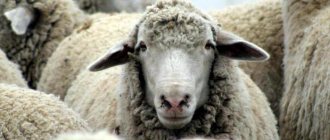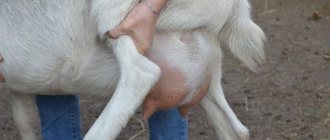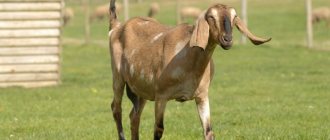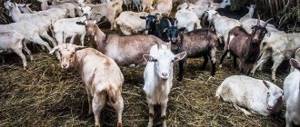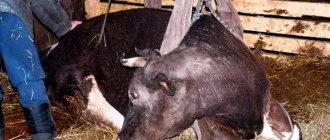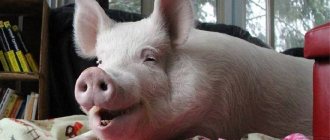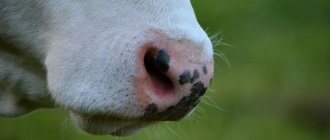BLOOD IN A GOAT'S MILK
BLOOD IN THE MILK OF A GOAT.
The appearance of any amount of blood in milk indicates a serious problem with the udder. What causes the appearance of blood and what should be done in each specific case?
1. Inflammation of the udder (mastitis) is the most common cause of blood in milk. Why does blood appear? During the inflammatory process, the permeability of the walls of blood vessels increases and some of the blood elements (erythrocytes - red blood cells) enter the milk. turning it pink.
Blood in milk is a very important diagnostic sign. which allows us to identify the presence of not only acute. but also hidden. asymptomatic. chronic inflammatory process.
What to do. If mastitis is not acute and there is not a significant amount of blood in the milk. Before starting treatment, put the milk into the tank. laboratory for analysis: bacterial culture of milk and determination of sensitivity to antibiotics. This study will allow you to accurately select the most effective antibiotic. rather than experimenting. sorting through useless drugs and destroying in the process of “treatment”, instead of harmful bacteria in the udder, the beneficial microflora of the digestive tract
If mastitis is acute. Treatment should be started without waiting for the results of the study. without delay. Treatment should be comprehensive and include the simultaneous use of several drugs. antibiotics. hemostatic drugs, immunostimulants. homeopathic remedies.
If there is bleeding, do not massage the udder too much. milk dry or milk. Always use special semi-fat creams for milking. for example "Zorka" or baby cream. Do not rub irritating ointments and oils into the udder. as they increase blood flow to the mammary gland. which means they increase inflammatory edema. capillary fragility and bleeding.
1. Antibiotics. for example, cefazolin 1g is diluted in 4 ml. novocaine and administered intramuscularly 2 times a day, one bottle for 7 days.
2. Hemostatic drugs. dicinone (or vikasol) 1 ampoule (2 ml.) intramuscularly 2 times a day for 3 days in a row. then break for 2 days and repeat.
3. Vit. From 2 ml. 1 time per day IM 5 days
4. Immunostimulants. Immunofan 1 ampoule IM 1 time per day for 5 days 5. Homeopathic medicines. traumatin 3 ml. + mastomethrin 3 ml. (in one syringe) 2 times a day IM for 5 days.
The use of homeopathic remedies is not strictly necessary. but nevertheless very desirable. especially with chronic mastitis. Attention. Homeopathic remedies can stop mastitis. but it will not cure mastitis. They are used only as an addition to the main treatment complex. Antibiotics cannot be replaced with homeopathy. Because. that homeopathic medicines do not destroy pathogenic bacteria. which means they do not eliminate the cause of mastitis.
Injury or bruise to the udder is another common cause of blood in milk. Injuries can occur due to a blow to the udder with a horn. the hoof or head of another goat. falls. jumping over obstacles. On impact. despite. that there is no open wound left on the udder and the skin is not damaged. There is always a rupture of the internal tissues of the mammary gland. small and medium blood vessels and multiple hemorrhages. With further development of inflammation at the site of the bruise.
What to do For any injury, treatment begins with the administration of painkillers. Relieving pain helps the injured tissue heal better.
1. The goat is injected with 2 ml. analgin intramuscularly 3 times a day for 5 days.
2. Prednisolone or dexamethasone is prescribed as an anti-shock and anti-inflammatory drug. Prednisolone (or dexamethasone) is administered 1 ml. intramuscularly 1 time per day for 5 days.
3. If abrasions are found at the site of the injury. they are treated with iodine. The bruise site is lubricated (without rubbing) with ointment (gels): “Travmatin”. "Bodyaga 911", "Heparin". Or treated with anti-inflammatory sprays. "Chemi spray" "Terramycin spray".
4.Antibacterial. hemostatic and immunostimulating agents Prescribed in exactly the same way as above for the treatment of mastitis
5.Homeopathic remedies are extremely effective in treating all types of injuries. Travmatin is administered in 3 ml doses. 2 times a day intramuscularly for 5-7 days in a row.
6. Mode. diet. milking. The goat is provided with peace. limit water. exclude succulent foods. swill - until the appearance of blood in the milk stops. They milk very carefully.
Treatment regimen for injury.
1. analgin 2 ml. 3 times a day
2. prednisolone 1 ml. 2 times a day 5 days
3.cefazolin 1g. 2 times a day 7 days
4. Vikasol 2 ml. 2 times a day for 3 days. then break for 2 days and repeat.
5. vit.C 2 ml. 1 time per day 7 days
6.immunofan 1 ampoule 1 time per day for 5 days
7. Traumatin 3 ml. 2 times a day 5-7 days
Attention. For open, penetrating wounds of the udder, be sure to call a doctor. Such a wound needs to be sutured. layer-by-layer sutures. Only a veterinarian will perform such an operation correctly.
3. Violation of the rules of manual milking
Pinch milking causes blood to appear in the milk. When milking with a pinch, the delicate tissue of the mammary gland is damaged. capillaries (small blood vessels) rupture and hemorrhage occurs. Traumatic milking with a pinch provokes the formation of small brushes around the nipple.
What to do. The only correct way to milk is to milk with your fist. You can only use a pinch to milk the remaining milk. after the final udder massage. Doing it extremely carefully.
Blood in the milk can appear if the goat is milked alternately by not very skilled family members. I injure the fragile blood vessels of the udder with my rough actions. Only one experienced housewife should milk at all times.
4. Increased capillary permeability is a complication after chronic mastitis. This is the persistent appearance of blood in milk despite all the treatment. The reason is a previously suffered long-term chronic inflammation of the udder. due to which increased permeability of the walls of blood vessels remains.
Treatment. I have encountered cases of such persistent bleeding. And we managed to find an effective treatment for this particular condition. The use of roncoleukin gives very good results. Roncoleukin is an immunostimulant. has a pronounced anti-inflammatory effect.
Read also: Watussi bull: what it looks like, where it lives, what it eats
Roncoleukin is administered (strictly!) subcutaneously. in a dose of 100,000 units. in one day. The course of treatment is 6 injections. This medication should not be stored once opened. therefore, you need to buy ampoules of only the administered dosage. Despite. that the blood in the milk disappears after 3-4 injections. The course is carried out in full. It is possible (in rare cases) for the blood to reappear after a few weeks. Then the treatment is repeated and the bleeding stops completely.
Required condition. Before using Roncoleukin, it is necessary to submit milk for bacterial analysis - the udder must be healthy. without the presence of pathogenic microflora in milk. Staphylococcus epidermidis should not be present. since in large quantities it causes inflammation of the udder. Treatment begins with the use of a/b for mastitis. and only then is it carried out - strengthening the capillaries with roncoleukin.
The goat has blood in its milk, but does not have mastitis. Help is needed.
Questions can only be asked after registration.
Please login or register. In the evening I told my wife and she also noticed. I called a friend, he said it was mastitis. I bought a test and tested the milk with it. The test is negative. Help with advice on how to treat. Symptoms in a goat: one teat is larger than the other, kicks when milking. The udder is hot. There is blood and flakes in the milk. She eats well and is active.
Either mastitis (take a test at a veterinary laboratory for mastitis with subtitration for sensitivity to antibiotics, so that you immediately know exactly what to treat), or you are milking incorrectly and injuring the vessels (but then there would be blood without flakes and the udder would not be hotter). Evaluate the milking technique; the vessels are more often injured in the place where the nipple meets the udder, grab lower and milk more gently.
Do you milk with a pinch or with your fist? Pinching is the most traumatic method. Now you can give the goat ascorutin 2 tons per day for 1 month. You can smear the udder with pikhtoin ointment at night (in a veterinary pharmacy) during the day with ichthyol (but do not drink milk after ichthyol). A goat kicks because it experiences discomfort or pain during milking. Isn't her udder swollen?
We live together in harmony, because without a cat, a house is not a Home! With a cat it’s Home, but without a dog it will be very sad!)
There is a Mast test at home.
Hidden and chronic may not be determined.
Enlarge one nipple.
The nipples are not symmetrical. Is the udder hot on this side? Milk separately in different containers from both lobes. Let it stand separately and see where there is blood and sediment.
Yes, and the sore nipple is not immediately milked, you need to massage it first and then the milk just comes out.
You need to massage it first and then the milk just comes out.
If you have mastitis, active massage is contraindicated. There is also the option of something traumatic (a blow or severe compressive swelling). Then clots can form in the milk, which clog the channels and interfere with milking. This happened to one of my goats; after laboratory exclusion of mastitis, the whole head was broken until the cause was found (with the help of very good...
an experienced goat breeder.. here on the forum her nickname is G.T.A. blog "Goat-Rosochka"). These casein clots are clearly visible during milking and when filtering freshly milked milk. In this case, milk more often than 2 times a day, first massage the nipples, move like men knead cigarettes in their fingers, smear with fir, give ascorutin, add brine from cucumbers (salted, not canned) or lemon juice.
Why does a goat's milk contain blood?
Goat milk is considered dietary; it is richer in fat and protein content than cow milk. Problems with the pet's health, especially the appearance of blood in the milk, cause grief for the owners. This article will introduce novice goat breeders to the causes of the disease and tell you what to do if it occurs.
There are the following reasons for the appearance of blood in a goat's milk:
- secretion stagnation;
- injury;
- complication after drug treatment.
Milk stagnation
The goat's udder becomes inflamed for the following reasons:
- violation of content parameters;
- non-compliance with milking rules;
- feeding errors;
- inflammation of the reproductive organs.
Violation of content parameters
Keeping a goat in a damp room on a concrete floor, especially if the animal is milking, contributes to the occurrence of edema. Milk stagnates in the gland, compresses the parenchyma, and injures it. The attached microflora melts the walls of the capillaries. Bleeding occurs and a bloody sediment forms in the milk.
Non-compliance with milking rules
Dirty hands, rarely changing towels, lack of hygienic treatment of the udder, inept milking, injure the mammary gland, causing inflammation, swelling and mastitis.
Feeding errors
Overfeeding with concentrates or feeding excessively wet greens or vegetables causes disruption of rumen digestion. Endotoxins released by microbes in the proventriculus irritate the udder parenchyma, leading to the development of mastitis. In spoiled sweet clover hay, anticoagulants are formed, which increase the porosity of the capillaries, the blood from which enters the milk.
If the owner has driven a hungry animal out to a burnt-out pasture, the goat will only be able to find drought-resistant harmful plants on it. When eating milkweed, buttercup or bedstraw, the goat's milk turns pink. If the kids drink it, nothing bad will happen to them.
If feed is stored carelessly, it is affected by fungi that produce mycotoxins, which are capillary poisons. Eating concentrates or hay spoiled by micromycetes can lead to the development of mastitis, characterized by the appearance of blood in the milk.
Inflammatory processes of the reproductive organs
Problems after lambing - delay in expulsion of the placenta, endometritis, vaginitis, are characterized by the spread of relatively pathological contagions through the lymphatic network to the udder, its contamination, and the occurrence of mastitis. The disease occurs in latent, acute and permanent forms.
Bruises, cuts, and punctures in the udder result in inflammation, leading to the development of mastitis. A goat can get injured in the pasture by pricking its swollen mammary gland on the fruits of a cocklebur or the ground part of a thistle, jumping over ditches or sorting out relations with its own kind.
Complication after drug treatment
How to treat a disease that causes blood in milk? The therapeutic concept combines analgesic, anti-inflammatory and antimicrobial treatment. External ointments containing iodine, camphor, lidocaine or novocaine are used to relieve pain and, partially, inflammatory effects. Antiseptic aerosols, for example, Terramycin spray, have a good antiphlogistic effect.
Why are proposals to titrate antibiotics wrong? Because before receiving test results, treatment can be carried out with other means. Long-acting broad-spectrum antibiotics are used based on the following considerations:
- achieving the required concentration of the active substance and maintaining it at a high level for a long time;
- low labor costs;
- calmness of the goat, its minimal traumatization;
- no side effects that destroy microflora and cause dysbacteriosis;
- short period of removal of the antibiotic from the body.
Nitox meets these requirements. The medicine is administered once; in severe situations, the injection is repeated a day and a half later. The allowance for milk is a week, for meat - three. The veterinarian may prescribe Vikasol or another hemostatic drug in addition to the main treatment.
If the goat breeder considers the waiting period to be excessive, he can use Dorin or Ceftriaxone, but he must be prepared for the development of dysbacteriosis, and also use Nystatin in parallel to suppress fungi.
You should not use tablets or powder antibiotics orally, because they have a detrimental effect on the microflora of the intestine and rumen, causing atony of the proventriculus.
If injection treatment does not lead to the expected effect, intracisternal treatment is used. The Russian veterinary industry produces Mastisan, which combines the action of several antibiotics and a sulfonamide drug. The medication, in the form of an oily substance, is packaged in syringes, which are inserted into the nipple canal and squeezed into the udder lobe.
Foreign-made drugs - Tetra-Delta, as well as Mastiet-Forte, in addition to antimicrobial active ingredients, contain the antiphlogistic painkiller Prednisolone.
During the treatment period, the goat is provided with comfort, is not driven out to pasture, and contacts with other individuals are interrupted. Exclude dairy feeds, limiting yourself to good hay, preferably forbs or cereals, twig brooms, and dried green mass. The goat is regularly milked, freeing the udder from pathological secretions, which should not be given to the kid to drink.
Immunomodulators and homeopathic remedies recommended for use must be considered as additional ones with the approval of a veterinarian.
Causes
There are the following reasons for the appearance of blood in a goat's milk:
- secretion stagnation;
- injury;
- complication after drug treatment.
Milk stagnation
The goat's udder becomes inflamed for the following reasons:
- violation of content parameters;
- non-compliance with milking rules;
- feeding errors;
- inflammation of the reproductive organs.
Violation of content parameters
Keeping a goat in a damp room on a concrete floor, especially if the animal is milking, contributes to the occurrence of edema. Milk stagnates in the gland, compresses the parenchyma, and injures it. The attached microflora melts the walls of the capillaries. Bleeding occurs and a bloody sediment forms in the milk.
Non-compliance with milking rules
Dirty hands, rarely changing towels, lack of hygienic treatment of the udder, inept milking, injure the mammary gland, causing inflammation, swelling and mastitis.
A skilled milkmaid will not allow the development of udder inflammation
Feeding errors
Overfeeding with concentrates or feeding excessively wet greens or vegetables causes disruption of rumen digestion. Endotoxins released by microbes in the proventriculus irritate the udder parenchyma, leading to the development of mastitis. In spoiled sweet clover hay, anticoagulants are formed, which increase the porosity of the capillaries, the blood from which enters the milk.
If the owner has driven a hungry animal out to a burnt-out pasture, the goat will only be able to find drought-resistant harmful plants on it. When eating milkweed, buttercup or bedstraw, the goat's milk turns pink. If the kids drink it, nothing bad will happen to them.
Bedstraw
If feed is stored carelessly, it is affected by fungi that produce mycotoxins, which are capillary poisons. Eating concentrates or hay spoiled by micromycetes can lead to the development of mastitis, characterized by the appearance of blood in the milk.
Inflammatory processes of the reproductive organs
Problems after lambing - delay in expulsion of the placenta, endometritis, vaginitis, are characterized by the spread of relatively pathological contagions through the lymphatic network to the udder, its contamination, and the occurrence of mastitis. The disease occurs in latent, acute and permanent forms.
Mastitis
Injuries
Bruises, cuts, and punctures in the udder result in inflammation, leading to the development of mastitis. A goat can get injured in the pasture by pricking its swollen mammary gland on the fruits of a cocklebur or the ground part of a thistle, jumping over ditches or sorting out relations with its own kind.
A goat injures its udder in a fight
Complication after drug treatment
Inflammation of the udder can begin after prolonged treatment with antibiotics or other medications, which disrupt blood clotting processes. Thus, antimicrobial drugs inhibit beneficial microflora that synthesize Phylloquinone precursors. Vitamin deficiency develops, accompanied by high permeability of small vessels and blood leaking out of them. Another side effect of drug antimicrobial therapy is the excessive proliferation of conditionally pathogenic fungi, which makes small vessels fragile and prone to bleeding.
Why does a goat have milk with blood: the main reasons
The presence of blood in milk is associated with udder problems. This could be mechanical damage or an infectious disease.
The most common cause of pink milk is mastitis, an inflammatory process of the mammary gland of an infectious nature. Usually it occurs without pronounced symptoms, which makes this disease quite dangerous, since it is difficult to suspect it right away. A signal of a problem may just be the milk turning pink.
Associated symptoms
In addition to the fact that a goat with mastitis produces milk mixed with blood, the following symptoms are also observed:
- decline in milk yield;
- milk turns sour quickly;
- milk is difficult to milk;
- the udder is swollen (often unevenly);
- the temperature of the udder is higher than the temperature of the rest of the goat’s body;
- when palpating the organ, compactions are noticeable;
- the animal loses its appetite;
- Milk contains mucus, flakes, and clots.
Causes of the disease
The causative agents of mastitis are bacteria:
- Staphylococcus aureus;
- groups of streptococci (Str. agalactiae and Str. dysgalactiae);
- Bacillus cereus;
- Corynebacterium bovis;
- Pseudomonas aeruginosa;
- Proteus vulgaris;
- Klebsiella oxytoca;
- E. coli.
But not only these bacteria can provoke the development of the disease.
There are other reasons:
- colds (due to dampness, drafts, low temperature in the barn);
- poor living conditions (damp litter, unsanitary conditions);
- violations of milking technique (lack of hygiene, lack of massage, improper use of the milking machine);
- injuries to the udder, nipples;
- diseases of the reproductive system;
- violation of the livestock reproduction system (early mating, small interval between births);
- violation of livestock maintenance (neighborhood of sick and healthy animals).
First of all, the sick individual must be isolated from the rest in order to avoid the massive development of the disease. She is provided with the best living conditions: a warm, clean room. The bedding is changed and the room is cleaned regularly. Juicy feed and mixed feed are excluded from the diet. Drinking is limited to a minimum and only warm drinks are given.
The following treatment options are commonly used:
- A course of antibiotics intramuscularly along with drugs that are injected into the udder.
- Novocaine blockades in combination with antibiotics.
- Folk remedies only if the disease is at an early stage (calendula-based ointment for rubbing, chlorophyllipt with novocaine for injection into the udder, ichthyol ointment).
Stagnant processes most often occur in young goats, first-born goats. They can arise due to impaired blood circulation and lymph circulation in the mammary gland in the last stage of pregnancy. They are manifested by enlargement of the udder and absence of pain on palpation. The organ feels like dough.
Violation of content rules
If the animal is kept on a concrete floor without bedding and in damp conditions, then with frequent milking, swelling of the udder immediately occurs. Milk stagnation occurs, as a result of which the parenchyma (glandular tissue that produces milk) is injured. Microflora is involved in the process, which destroys the capillaries, which is why blood appears in the milk.
Incorrect milking
Unwashed hands of the milkmaid, lack of hygiene procedures for the udder before and after milking, inept milking, which causes injury to the organ, provoke the development of the inflammatory process, the appearance of edema, and mastitis. As a result, the milk turns pink.
Wrong diet
Building a diet based on concentrates or the presence of very wet greens or vegetables in the menu causes a malfunction of the gastric rumen. The fermentation process occurs. The microorganisms taking part in it spread throughout the body and, entering the udder, irritate the parenchyma. The result is mastitis.
Udder injuries
In a barn or on a pasture, a goat can easily get a bruise on the udder, cut or prick it. Such an injury is accompanied by an inflammatory process, which often develops into mastitis. Usually, if the udder has just been injured, the milk will turn bright red. When hematomas begin to form, the bright color will fade and clots will appear.
Is it possible to drink milk with blood?
Milk mixed with blood is not suitable for either humans or goats. It may contain pathogenic microorganisms, its chemical composition is changed. The boiling procedure can kill harmful microflora, but is in no way capable of returning lost nutrients.
So, blood during milking can appear both due to illness and due to improper maintenance and care of the animal. Therefore, it is very important to monitor the condition of the premises in which the herd lives and its diet.
Blood in goat milk
Blood in milk is a common defect in goats, associated with inflammation, trauma to the mammary gland and other reasons. The milk takes on a pink tint, or individual streaks and blood clots are visible at the bottom of the container. Treatment depends on the cause of the appearance of blood in milk; for mastitis, massage and warming procedures should be carried out, and if the appearance of blood is associated with a bruise, then these manipulations are contraindicated.
Predisposing factors to the appearance of bloody milk are poor maintenance and care, lack of therapeutic and preventive work on the farm. If there are metal rods sticking out in your barn and pen, the pressure in the milking machine is not adjusted, and you have only just learned about preparing for lambing and medical examination, then blood will definitely appear in the milk of your goats.
What to do if blood appears in milk:
- find out the reasons (bruise, inflammation, poor care, etc.);
- eliminate them (improve maintenance, set up a milking machine, treat the underlying disease, etc.);
- prevent the secondary appearance and disease of other goats.
The question of whether you can drink milk with blood is difficult to answer. On the one hand, if the appearance of blood is not associated with an infectious process, then you can drink milk. But on the other hand, the presence of an impurity makes the product less pleasant. Therefore, it is better to use blood milk to feed other animals.
Read also: Swelling of the udder in a cow after calving: why, what to do, how to treat
Causes of blood in milk
The presence of blood mass in milk is directly related to pathological processes in the udder. This phenomenon can be provoked by mechanical stress or infection. The most common cause of pink milk is mastitis. This pathology is an inflammatory process in the mammary glands. The source of danger for a goat is infection.
Pathological processes occur without any pronounced symptoms. The absence of signs of the disease makes it very dangerous. A change in the color of the milk indicates problems with the animal's health.
Udder injury is the first cause of bloody milk
Any mechanical damage to the goat's mammary gland leads to the appearance of bloody milk. These can be wounds, bruises, hematomas. There are various reasons for this:
Immediately after the injury, blood and a bright red color are found in the milk. But as the hematoma forms, the coloring is replaced by dense clots. Minor damage to blood vessels quickly becomes invisible - instead of pronounced blood clots, small elastic formations can be found, as in the photo. This is fibrin, a protein responsible for blood clotting.
If the udder is damaged, in addition to blood, pain and swelling are noted. A hematoma, an accumulation of blood under the skin, may form. The goat does not allow you to touch the gland, milking becomes difficult, and milk yield decreases. The udder becomes hot and swollen.
- provide rest to the sick goat, remove the kids and other animals;
- apply ice or a cold compress on the first day after the injury;
- milk carefully, it is better to install a milk catheter;
- from the second day, thermal procedures are used;
- on the 3rd day, you can carefully apply massage, rubbing in ichthyol or other ointment.
To prevent bruises from recurring, you need to make high-quality sheds and pens, remove all debris and prevent its appearance. Properly organize the work of the milkmaid and milking equipment. Breed hornless animals.
Udder inflammation
Mastitis is the most common udder disease. More often it occurs without significant symptoms. By the periodic appearance of blood in the milk, one can suspect latent mastitis in a goat. More details about this pathology are written in the article about mastitis in goats. Here we will focus on the main points and a special form of inflammation - hemorrhagic mastitis.
More often, animals have latent mastitis (subclinical). Signs of the disease are invisible, or they are not paid attention to, as the goat continues to milk. You may notice a decrease in productivity, blood and white clots at the beginning of milking. But the disease can be completely excluded only by special diagnostics for mastitis - a detailed description of the study.
Treatment is necessarily comprehensive. Suspensions of antibiotics (Mastisan, Gamaret) are injected through the nipple canal, ichthyol, firtoin are applied to the skin of the udder and massage is performed. It is useful to do warming procedures. Novocaine blockade of the udder is very effective.
Hemorrhagic mastitis
What should a goat owner do? It is better to contact a veterinarian, but if this is not possible, then acute inflammation and swelling should be eliminated as quickly as possible. To do this, it is necessary to divert the blood from the udder - laxatives, diuretics, rubbing irritating ointments in the sternum area. The cause of swelling is an excess of succulent feed and water, they are limited.
Hemorrhagic inflammation is characterized by severe pain - udder massage will only worsen the disease and in this case it is contraindicated until the end of the acute process. Ointments can be used, but they are first rubbed with the palms of your hands and then carefully applied to the skin of the udder. It is important to prevent the formation of blood clots - frequent and careful milking, rinsing the gland with saline solution.
Treatment regimen for hemorrhagic mastitis:
- mastomycin – 2 times a day, intrauderminally into each lobe, course – 3 days;
- novocaine blockade of the udder;
- amoxigard – intramuscularly at a dose of 1 ml per 20 kg of weight, once a day, course – 5 days;
- calcium preparations – borogluconate, gluconate, chloride. Reduce bleeding.
The simultaneous use of local and systemic antibiotics is explained by the septic process, frequent concomitant endometritis and other diseases. Novocaine blockade is very important, since bloody mastitis is associated with severe pain.
For the same reason, Mastomycin is used - this complex antibacterial drug for intraudericular administration contains lidocaine. Before administering the drug, it is necessary to empty the affected portion of the udder from the contents, disinfect the nipple, and after administration, perform a light massage of the nipple from bottom to top. Depending on the severity of the inflammatory process, drugs are administered until the affected lobes of the udder are completely cured.
If amoxigard is not available, then antibiotics are administered intramuscularly:
- vetbitsin for goats 5-10 thousand units/kg. (it is more effective to dilute with the Vitam complex: vitamins + amino acids);
- Nitox 200 (1 ml/10 kg live weight).
When the acute stage passes, compensatory measures are taken, as with chronic mastitis. The udder is massaged, ichthyol, camphor, and salicylic ointment are rubbed in. Warming the udder helps eliminate knots.
Treatment
How to treat a disease that causes blood in milk? The therapeutic concept combines analgesic, anti-inflammatory and antimicrobial treatment. External ointments containing iodine, camphor, lidocaine or novocaine are used to relieve pain and, partially, inflammatory effects. Antiseptic aerosols, for example, Terramycin spray, have a good antiphlogistic effect.
Why are proposals to titrate antibiotics wrong? Because before receiving test results, treatment can be carried out with other means. Long-acting broad-spectrum antibiotics are used based on the following considerations:
- achieving the required concentration of the active substance and maintaining it at a high level for a long time;
- low labor costs;
- calmness of the goat, its minimal traumatization;
- no side effects that destroy microflora and cause dysbacteriosis;
- short period of removal of the antibiotic from the body.
Nitox meets these requirements. The medicine is administered once; in severe situations, the injection is repeated a day and a half later. The allowance for milk is a week, for meat - three. The veterinarian may prescribe Vikasol or another hemostatic drug in addition to the main treatment.
If the goat breeder considers the waiting period to be excessive, he can use Dorin or Ceftriaxone, but he must be prepared for the development of dysbacteriosis, and also use Nystatin in parallel to suppress fungi.
You should not use tablets or powder antibiotics orally, because they have a detrimental effect on the microflora of the intestine and rumen, causing atony of the proventriculus.
If injection treatment does not lead to the expected effect, intracisternal treatment is used. The Russian veterinary industry produces Mastisan, which combines the action of several antibiotics and a sulfonamide drug. The medication, in the form of an oily substance, is packaged in syringes, which are inserted into the nipple canal and squeezed into the udder lobe.
Foreign-made drugs - Tetra-Delta, as well as Mastiet-Forte, in addition to antimicrobial active ingredients, contain the antiphlogistic painkiller Prednisolone.
During the treatment period, the goat is provided with comfort, is not driven out to pasture, and contacts with other individuals are interrupted. Exclude dairy feeds, limiting yourself to good hay, preferably forbs or cereals, twig brooms, and dried green mass. The goat is regularly milked, freeing the udder from pathological secretions, which should not be given to the kid to drink.
Nipple wounds
The appearance of a small amount of blood in the milk may be due to wounds on the goat's nipples. In this case, severe bleeding will be noticeable at the very beginning and in case of serious damage (laceration of the nipple in the photo).
More often, goats develop small wounds and cracks, usually in the nipple canal, the disease is accompanied by the following changes:
- small clots at the beginning of milking;
- painful reactions when squeezing the nipples, palpation of the udder does not cause discomfort;
- a small amount of blood during milking (the wound opens due to secondary damage by the milker or the machine).
After milking, the canal should be washed with furatsilin or potassium permanganate. You can use hydrogen peroxide - it helps stop bleeding. Calcium borgluconate should be administered subcutaneously in a dose of 50 ml once a day, course 3-5 days. Milking should be done carefully.
